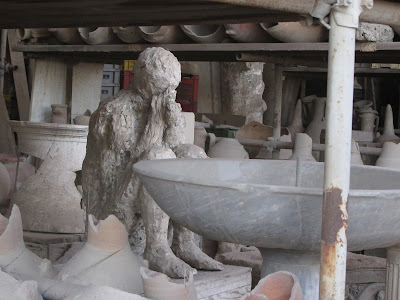A couple weeks ago, we spent a full day in Pompeii. I was amazed by the size of it--it stretched on and on! I don't think I had previously fully understood that literally an entire city was preserved by Vesuvius' eruption. The variety of buildings, houses, villas, and marketplaces was pretty remarkable. I felt as though I was dropped into a diorama of an ancient Italian city, except it was life-size (and packed with tourists... Rome is full of them, but Pompeii cycles through thousands of people daily). It was pretty amazing to see something I remember learning about in second grade homeschooling and freshman year of high school. I took a couple hundred pictures, so here is a selection.
The basilica. Those diminutive pillars weren't destroyed by the volcano eruption--those tumbled during an earthquake just a few years before Vesuvius let off some steam. It was a rough decade for Pompeii.
A sun dial! :) I thought this was pretty sweet. Check out that blue sky--it was a clear, hot day, without a cloud.
One of my favorite parts of Pompeii is the mountains. It's perched surrounded by a ring of peaks that fade into the distance... Vesuvius is a pretty constant presence, too. It managed to sneak into most of my pictures, and I had to stop myself from posting about ten of them. It isn't in this shot, though--this is of the forum, with different types of markets and temples adjoining.
This was very touching. It's the body of a little child who is huddled up and praying or covering his face.
Early on in the excavations, an archeologist filled most of the preserved bodies with plaster. That's why this little guy looks a little statue-esque. They also consolidated most of the pottery, artifacts, and bodies. In fact, most of the bodies were not on display (I was a little disappointed by the scarcity of them... I guess I was just expecting to see more dead people. Is that morbid?). However, there were more than enough houses and villas to compensate!
Archways. Traveler.
I felt a little blonde when I realized there was an actual living city of Pompeii, too. It's perfectly natural for people to live in the area, and for a city to spring up here, but for some reason I didn't expect it. Here's the remains of a temple in the foreground with the modern Pompeii behind. And more mountains!!
This was taken near the Villa of Mysteries (more about that later). I get really excited whenever I see living things around ruins, as I mentioned in my
post on the Palatine Hill.
There it is!! Vesuvius! It's still technically an active volcano. Kristen, our Site Director, informed us that if it erupts, it's every man for himself, but she's planning on running for the ocean.
Inside the courtyard of the Villa of Mysteries (one of the largest preserved villas in Pompeii). Some very wealthy people lived here, who appeared to be involved in a cult, based on...
...this fresco! The entire house was full of incredibly preserved frescoes (keep in mind that they're all dating to pre-79 A.D.), and this one appears to display a pagan ritual that may have been an initiation right for a new female member. They have no idea what its real purpose is, though--thus the name "Villa of Mysteries."
Isn't the red background striking?
Grave stone. Looks a bit like an altar, huh?
The detailed tiling is pretty amazing. I love the geometric shapes here--they remind me of those pattern blocks I used to play with when I was little (and still enjoy ever time my nephews and nieces are over!).
Garden of another large villa... This one had a detailed mosaic that copied
this painting, but I didn't get a good picture of it.
Pompeii is actually pretty full of dogs. It's actually almost like an animal shelter--the dogs are protected within the city limits, so stray dogs shelter in the ruins.
One of Pompeii's roads. These still blow my mind... the middle, main portion of the road is paved with wide flag-stones and is dropped about six inches lower than the rest of the street. They actually flooded the streets every so often to clean them--there are large stepping stones across the road every few blocks so that pedestrians could cross even when it was flooded.
The amphitheatre! It looks almost new... and it's two thousand years old. We enjoyed perching in the upper rows to take a break from pushing past German-speaking tour-groups and over-heated middle-aged Americans. The wide feeling of space was refreshing after fairly narrow streets and mostly small houses.
Lovely friends. :)
Vesuvius, through a window...
Another example of a street. The multiple-story building in the background is modern... but there are two-story buildings in Pompeii!
This courtyard was very tranquil (if gated off..).
Another of my favorites--the arena.
Inside. I think I liked how secluded it was. It's in the southeast corner of the city, so it's a little less accessible. We actually thought it was closed until we found a hidden entrance. It turns out that persistence pays off in settings like this.
Sign by the arena. I really wish I read Latin.
As a whole, Pompeii was almost overwhelming. The organization of the excavations is impressive, as is the layout of the streets themselves--it looks as though city planners were active a couple thousand years ago, too. I was again reminded of the fact that people actually lived there when I filled my water bottle at the (still in-use) fountains, and when I passed large orchards of pomegranate trees. Although I was frustrated by how crowded it was and that many sections were either closed or barred off, at the end of the day, we still saw Pompeii and stepped into a different millennia. That doesn't happen every day. :)
























































